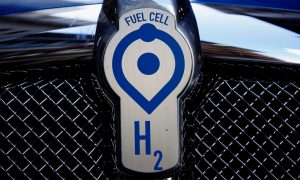
Researchers have come up with a new system that turns seawater into hydrogen fuel—a development that could aid in the proliferation of hydrogen fuel cell vehicles.
The new method extracts hydrogen from the ocean by funneling seawater through a double membrane system, using electricity. The design was successful in generating hydrogen gas without the accompaniment of large quantities of harmful byproducts.
Vehicles with hydrogen fuel cells are fed with compressed hydrogen gas. The fuel cells do not burn this gas. Instead, cells transform the chemical energy of the fuel into electrical energy, which then powers the vehicle’s electric motors. The only byproduct is pure water, with zero tailpipe emissions.
“Many water-to-hydrogen systems today try to use a monolayer or single-layer membrane. Our study brought two layers together,” said Adam Nielander, an associate staff scientist with the SUNCAT Center for Interface Science and Catalysis, a SLAC-Stanford joint institute, according to an April 11 news release.
“These membrane architectures allowed us to control the way ions in seawater moved in our experiment,” he added. Results of the study were published in the Joule journal on April 11.
The Double Membrane System
Researchers tested out their double membrane system using electrolysis—a method that uses electricity to drive ions to run a desired reaction. The most harmful element to the seawater system is chloride, says Joseph Perryman, a SLAC and Stanford postdoctoral researcher.
“There are many reactive species in seawater that can interfere with the water-to-hydrogen reaction, and the sodium chloride that makes seawater salty is one of the main culprits,” he said.
“In particular, chloride that gets to the anode and oxidizes will reduce the lifetime of an electrolysis system and can actually become unsafe due to the toxic nature of the oxidation products that include molecular chlorine and bleach.”
The bipolar membrane enables the generation of hydrogen gas while limiting the amount of chloride that gets to the reaction center.
According to Daniela Marin, a Stanford graduate student in chemical engineering and co-author of the study, there is also interest in using electrolysis to generate oxygen. In their experiment, the bipolar membrane was shown to produce oxygen gas as well.
Hydrogen Versus Electric-Only Agenda
Hydrogen fuel cells generally outperform lithium batteries when it comes to energy storage density, which gives them a major advantage in terms of the vehicle’s range. Fuel cells can also offer a longer lifespan.
A major carmaker focused on hydrogen fuel technology is Toyota, which owns more than 5,000 patents related to the technology. The company launched its hydrogen fuel cell electric vehicle Mirai in North America in 2015. However, the vehicle’s sales numbers have been dismal, only selling fewer than 10,000 units by January 2022.
Tesla CEO Elon Musk has dismissed the technology of hydrogen fuel cell vehicles, but Toyota insists that fuel cells are a viable option and that it allows the marketplace to remain diverse. Many existing vehicles can also be converted to use hydrogen fuel cells, allowing owners to retain their cars.
Talking with reporters during a visit to Thailand in December, Akio Toyoda, president of Toyota Motor Corp., had criticized carmakers pushing an electric-only agenda, stating that they do not reflect the market reality.
“People involved in the auto industry are largely a silent majority … That silent majority is wondering whether EVs [electric vehicles] are really OK to have as a single option,” he said.
“But they think it’s the trend so they can’t speak out loudly … Because the right answer is still unclear, we shouldn’t limit ourselves to just one option.”








